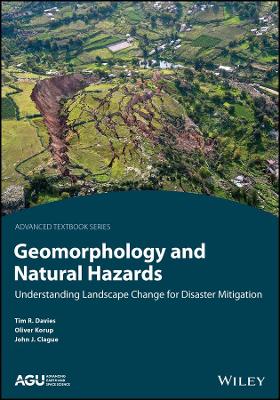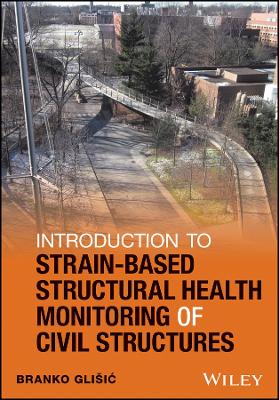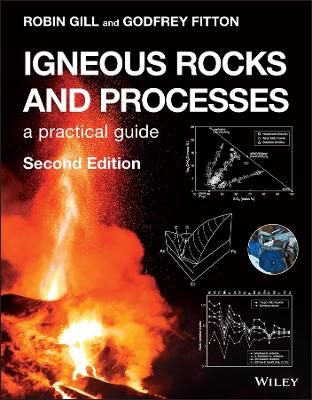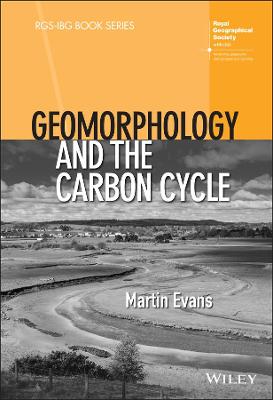Geomorphology and Natural Hazards
 -15%
portes grátis
-15%
portes grátis
Geomorphology and Natural Hazards
Understanding Landscape Change for Disaster Mitigation
Clague, John J.; Davies, Timothy R.; Korup, Oliver
John Wiley & Sons Inc
04/2021
576
Mole
Inglês
9781119990314
15 a 20 dias
1166
Descrição não disponível.
Preface xi
Acknowledgements xv
1 Natural Disasters and Sustainable Development in Dynamic Landscapes 1
1.1 Breaking News 1
1.2 Dealing with Future Disasters: Potentials and Problems 5
1.3 The Sustainable Society 10
1.4 Benefits from Natural Disasters 12
1.5 Summary 16
References 16
2 Defining Natural Hazards, Risks, and Disasters 19
2.1 Hazard Is Tied To Assets 19
2.1.1 Frequency and Magnitude 20
2.1.2 Hazard Cascades 24
2.2 Defining and Measuring Disaster 25
2.3 Trends in Natural Disasters 26
2.4 Hazard is Part of Risk 27
2.4.1 Vulnerability 28
2.4.2 Elements at Risk 32
2.4.3 Risk Aversion 35
2.4.4 Risk is a Multidisciplinary Expectation of Loss 36
2.5 Risk Management and the Risk Cycle 37
2.6 Uncertainties and Reality Check 39
2.7 A Future of More Extreme Events? 41
2.8 Read More About Natural Hazards and Disasters 43
References 46
3 Natural Hazards and Disasters Through the Geomorphic Lens 49
3.1 Drivers of Earth Surface Processes 50
3.1.1 Gravity, Solids, and Fluids 50
3.1.2 Motion Mainly Driven by Gravity 52
3.1.3 Motion Mainly Driven by Water 54
3.1.4 Motion Mainly Driven by Ice 56
3.1.5 Motion Driven Mainly by Air 56
3.2 Natural Hazards and Geomorphic Concepts 57
3.2.1 Landscapes are Open, Nonlinear Systems 57
3.2.2 Landscapes Adjust to Maximize Sediment Transport 59
3.2.3 Tectonically Active Landscapes Approach a Dynamic Equilibrium 62
3.2.4 Landforms Develop Toward Asymptotes 65
3.2.5 Landforms Record Recent Most Effective Events 68
3.2.6 Disturbances Travel Through Landscapes 69
3.2.7 Scaling Relationships Inform Natural Hazards 71
References 73
4 Geomorphology Informs Natural Hazard Assessment 77
4.1 Geomorphology Can Reduce Impacts from Natural Disasters 77
4.2 Aims of Applied Geomorphology 80
4.3 The Geomorphic Footprints of Natural Disasters 81
4.4 Examples of Hazard Cascades 86
4.4.1 Megathrust Earthquakes, Cascadia Subduction Zone 86
4.4.2 Postseismic River Aggradation, Southwest New Zealand 90
4.4.3 Explosive Eruptions and their Geomorphic Aftermath, Southern Volcanic Zone, Chile 93
4.4.4 Hotter Droughts Promote Less Stable Landscapes, Western United States 93
References 94
5 Tools for Predicting Natural Hazards 97
5.1 The Art of Prediction 97
5.2 Types of Models for Prediction 100
5.3 Empirical Models 102
5.3.1 Linking Landforms and Processes 102
5.3.2 Regression Models 107
5.3.3 Classification Models 109
5.4 Probabilistic Models 111
5.4.1 Probability Expresses Uncertainty 111
5.4.2 Probability Is More than Frequency 115
5.4.3 Extreme-value Statistics 119
5.4.4 Stochastic Processes 121
5.4.5 Hazard Cascades, Event Trees, and Network Models 122
5.5 Prediction and Model Selection 124
5.6 Deterministic Models 126
5.6.1 Static Stability Models 126
5.6.2 Dynamic Models 127
References 137
6 Earthquake Hazards 145
6.1 Frequency and Magnitude of Earthquakes 145
6.2 Geomorphic Impacts of Earthquakes 148
6.2.1 The Seismic Hazard Cascade 148
6.2.2 Postseismic and Interseismic Impacts 152
6.3 Geomorphic Tools for Reconstructing Past Earthquakes 154
6.3.1 Offset Landforms 155
6.3.2 Fault Trenching 158
6.3.3 Coseismic Deposits 161
6.3.4 Buildings and Trees 166
References 167
7 Volcanic Hazards 173
7.1 Frequency and Magnitude of Volcanic Eruptions 173
7.2 Geomorphic Impacts of Volcanic Eruptions 177
7.2.1 The Volcanic Hazard Cascade 177
7.2.2 Geomorphic Impacts During Eruption 177
7.2.3 Impacts on the Atmosphere 180
7.2.4 Geomorphic Impacts Following an Eruption 181
7.3 Geomorphic Tools for Reconstructing Past Volcanic Impacts 188
7.3.1 Effusive Eruptions 188
7.3.2 Explosive Eruptions 191
7.4 Climate-Driven Changes in Crustal Loads 195
References 197
8 Landslides and Slope Instability 203
8.1 Frequency and Magnitude of Landslides 203
8.2 Geomorphic Impacts of Landslides 210
8.2.1 Landslides in the Hazard Cascade 210
8.2.2 Landslides on Glaciers 212
8.2.3 Submarine Landslides 213
8.3 Geomorphic Tools for Reconstructing Landslides 213
8.3.1 Landslide Inventories 213
8.3.2 Reconstructing Slope Failures 215
8.4 Other Forms of Slope Instability: Soil Erosion and Land Subsidence 218
8.5 Climate Change and Landslides 220
References 225
9 Tsunami Hazards 233
9.1 Frequency and Magnitude of Tsunamis 233
9.2 Geomorphic Impacts of Tsunamis 236
9.2.1 Tsunamis in the Hazard Cascade 236
9.2.2 The Role of Coastal Geomorphology 237
9.3 Geomorphic Tools for Reconstructing Past Tsunamis 241
9.4 Future Tsunami Hazards 252
References 253
10 Storm Hazards 257
10.1 Frequency and Magnitude of Storms 257
10.1.1 Tropical Storms 257
10.1.2 Extratropical Storms 259
10.2 Geomorphic Impacts of Storms 261
10.2.1 The Coastal Storm-Hazards Cascade 261
10.2.2 The Inland Storm-Hazard Cascade 266
10.3 Geomorphic Tools for Reconstructing Past Storms 269
10.3.1 Coastal Settings 270
10.3.2 Inland Settings 273
10.4 Naturally Oscillating Climate and Increasing Storminess 275
References 280
11 Flood Hazards 285
11.1 Frequency and Magnitude of Floods 286
11.2 Geomorphic Impacts of Floods 289
11.2.1 Floods in the Hazard Cascade 289
11.2.2 Natural Dam-break Floods 291
11.2.3 Channel Avulsion 297
11.3 Geomorphic Tools for Reconstructing Past Floods 298
11.4 Lessons from Prehistoric Megafloods 306
11.5 Measures of Catchment Denudation 308
11.6 The Future of Flood Hazards 311
References 315
12 Drought Hazards 323
12.1 Frequency and Magnitude of Droughts 323
12.1.1 Defining Drought 324
12.1.2 Measuring Drought 325
12.2 Geomorphic Impacts of Droughts 326
12.2.1 Droughts in the Hazard Cascade 326
12.2.2 Soil Erosion, Dust Storms, and Dune Building 327
12.2.3 Surface Runoff and Rivers 332
12.3 Geomorphic Tools for Reconstructing Past Drought Impacts 334
12.4 Towards More Megadroughts? 339
References 342
13 Wildfire Hazards 345
13.1 Frequency and Magnitude of Wildfires 345
13.2 Geomorphic Impacts of Wildfires 348
13.2.1 Wildfires in the Hazard Cascade 348
13.2.2 Direct Fire Impacts 348
13.2.3 Indirect and Postfire Impacts 350
13.3 Geomorphic Tools for Reconstructing Past Wildfires 354
13.4 Towards More Megafires? 359
References 361
14 Snow and Ice Hazards 365
14.1 Frequency and Magnitude of Snow and Ice Hazards 365
14.2 Geomorphic Impact of Snow and Ice Hazards 367
14.2.1 Snow and Ice in the Hazard Cascade 367
14.2.2 Snow and Ice Avalanches 367
14.2.3 Joekulhlaups 374
14.2.4 Degrading Permafrost 375
14.2.5 Other Ice Hazards 379
14.3 Geomorphic Tools for Reconstructing Past Snow and Ice Processes 380
14.4 Atmospheric Warming and Cryospheric Hazards 384
References 389
15 Sea-Level Change and Coastal Hazards 395
15.1 Frequency and Magnitude of Sea-Level Change 399
15.2 Geomorphic Impacts of Sea-Level Change 404
15.2.1 Sea Levels in the Hazard Cascade 404
15.2.2 Sedimentary Coasts 404
15.2.3 Rocky Coasts 407
15.3 Geomorphic Tools for Reconstructing Past Sea Levels 408
15.4 A Future of Rising Sea Levels 411
References 414
16 How Natural are Natural Hazards? 419
16.1 Enter the Anthropocene 419
16.2 Agriculture, Geomorphology, and Natural Hazards 424
16.3 Engineered Rivers 430
16.4 Engineered Coasts 435
16.5 Anthropogenic Sediments 438
16.6 The Urban Turn 443
16.7 Infrastructure's Impacts on Landscapes 445
16.8 Humans and Atmospheric Warming 446
16.9 How Natural Are Natural Hazards and Disasters? 448
References 450
17 Feedbacks with the Biosphere 457
17.1 The Carbon Footprint of Natural Disasters 457
17.1.1 Erosion and Intermittent Burial 460
17.1.2 Organic Carbon in River Catchments 466
17.1.3 Climatic Disturbances 469
17.2 Protective Functions 473
17.2.1 Forest Ecosystems 473
17.2.2 Coastal Ecosystems 478
References 485
18 The Scope of Geomorphology in Dealing with Natural Risks and Disasters 495
18.1 Motivation 496
18.2 The Geomorphologist's Role 498
18.3 The Disaster Risk Management Process 499
18.3.1 Identify Stakeholders 500
18.3.2 Know and Share Responsibilities 501
18.3.3 Understand that Risk Changes 503
18.3.4 Analyse Risk 504
18.3.5 Communicate and Deal with Risk Aversion 505
18.3.6 Evaluate Risks 507
18.3.7 Share Decision Making 509
18.4 The Future - Beyond Risk? 511
18.4.1 Limitations of the Risk Approach 511
18.4.2 Local and Regional Disaster Impact Reduction 511
18.4.3 Relocation of Assets 513
18.4.4 A Way Forward? 514
References 516
19 Geomorphology as a Tool for Predicting and Reducing Impacts from Natural Disasters 519
19.1 Natural Disasters Have Immediate and Protracted Geomorphic Consequences 519
19.2 Natural Disasters Motivate Predictive Geomorphology 520
19.3 Natural Disasters Disturb Sediment Fluxes 521
19.4 Geomorphology of Anthropocenic Disasters 521
References 523
Glossary 525
Index 531
Acknowledgements xv
1 Natural Disasters and Sustainable Development in Dynamic Landscapes 1
1.1 Breaking News 1
1.2 Dealing with Future Disasters: Potentials and Problems 5
1.3 The Sustainable Society 10
1.4 Benefits from Natural Disasters 12
1.5 Summary 16
References 16
2 Defining Natural Hazards, Risks, and Disasters 19
2.1 Hazard Is Tied To Assets 19
2.1.1 Frequency and Magnitude 20
2.1.2 Hazard Cascades 24
2.2 Defining and Measuring Disaster 25
2.3 Trends in Natural Disasters 26
2.4 Hazard is Part of Risk 27
2.4.1 Vulnerability 28
2.4.2 Elements at Risk 32
2.4.3 Risk Aversion 35
2.4.4 Risk is a Multidisciplinary Expectation of Loss 36
2.5 Risk Management and the Risk Cycle 37
2.6 Uncertainties and Reality Check 39
2.7 A Future of More Extreme Events? 41
2.8 Read More About Natural Hazards and Disasters 43
References 46
3 Natural Hazards and Disasters Through the Geomorphic Lens 49
3.1 Drivers of Earth Surface Processes 50
3.1.1 Gravity, Solids, and Fluids 50
3.1.2 Motion Mainly Driven by Gravity 52
3.1.3 Motion Mainly Driven by Water 54
3.1.4 Motion Mainly Driven by Ice 56
3.1.5 Motion Driven Mainly by Air 56
3.2 Natural Hazards and Geomorphic Concepts 57
3.2.1 Landscapes are Open, Nonlinear Systems 57
3.2.2 Landscapes Adjust to Maximize Sediment Transport 59
3.2.3 Tectonically Active Landscapes Approach a Dynamic Equilibrium 62
3.2.4 Landforms Develop Toward Asymptotes 65
3.2.5 Landforms Record Recent Most Effective Events 68
3.2.6 Disturbances Travel Through Landscapes 69
3.2.7 Scaling Relationships Inform Natural Hazards 71
References 73
4 Geomorphology Informs Natural Hazard Assessment 77
4.1 Geomorphology Can Reduce Impacts from Natural Disasters 77
4.2 Aims of Applied Geomorphology 80
4.3 The Geomorphic Footprints of Natural Disasters 81
4.4 Examples of Hazard Cascades 86
4.4.1 Megathrust Earthquakes, Cascadia Subduction Zone 86
4.4.2 Postseismic River Aggradation, Southwest New Zealand 90
4.4.3 Explosive Eruptions and their Geomorphic Aftermath, Southern Volcanic Zone, Chile 93
4.4.4 Hotter Droughts Promote Less Stable Landscapes, Western United States 93
References 94
5 Tools for Predicting Natural Hazards 97
5.1 The Art of Prediction 97
5.2 Types of Models for Prediction 100
5.3 Empirical Models 102
5.3.1 Linking Landforms and Processes 102
5.3.2 Regression Models 107
5.3.3 Classification Models 109
5.4 Probabilistic Models 111
5.4.1 Probability Expresses Uncertainty 111
5.4.2 Probability Is More than Frequency 115
5.4.3 Extreme-value Statistics 119
5.4.4 Stochastic Processes 121
5.4.5 Hazard Cascades, Event Trees, and Network Models 122
5.5 Prediction and Model Selection 124
5.6 Deterministic Models 126
5.6.1 Static Stability Models 126
5.6.2 Dynamic Models 127
References 137
6 Earthquake Hazards 145
6.1 Frequency and Magnitude of Earthquakes 145
6.2 Geomorphic Impacts of Earthquakes 148
6.2.1 The Seismic Hazard Cascade 148
6.2.2 Postseismic and Interseismic Impacts 152
6.3 Geomorphic Tools for Reconstructing Past Earthquakes 154
6.3.1 Offset Landforms 155
6.3.2 Fault Trenching 158
6.3.3 Coseismic Deposits 161
6.3.4 Buildings and Trees 166
References 167
7 Volcanic Hazards 173
7.1 Frequency and Magnitude of Volcanic Eruptions 173
7.2 Geomorphic Impacts of Volcanic Eruptions 177
7.2.1 The Volcanic Hazard Cascade 177
7.2.2 Geomorphic Impacts During Eruption 177
7.2.3 Impacts on the Atmosphere 180
7.2.4 Geomorphic Impacts Following an Eruption 181
7.3 Geomorphic Tools for Reconstructing Past Volcanic Impacts 188
7.3.1 Effusive Eruptions 188
7.3.2 Explosive Eruptions 191
7.4 Climate-Driven Changes in Crustal Loads 195
References 197
8 Landslides and Slope Instability 203
8.1 Frequency and Magnitude of Landslides 203
8.2 Geomorphic Impacts of Landslides 210
8.2.1 Landslides in the Hazard Cascade 210
8.2.2 Landslides on Glaciers 212
8.2.3 Submarine Landslides 213
8.3 Geomorphic Tools for Reconstructing Landslides 213
8.3.1 Landslide Inventories 213
8.3.2 Reconstructing Slope Failures 215
8.4 Other Forms of Slope Instability: Soil Erosion and Land Subsidence 218
8.5 Climate Change and Landslides 220
References 225
9 Tsunami Hazards 233
9.1 Frequency and Magnitude of Tsunamis 233
9.2 Geomorphic Impacts of Tsunamis 236
9.2.1 Tsunamis in the Hazard Cascade 236
9.2.2 The Role of Coastal Geomorphology 237
9.3 Geomorphic Tools for Reconstructing Past Tsunamis 241
9.4 Future Tsunami Hazards 252
References 253
10 Storm Hazards 257
10.1 Frequency and Magnitude of Storms 257
10.1.1 Tropical Storms 257
10.1.2 Extratropical Storms 259
10.2 Geomorphic Impacts of Storms 261
10.2.1 The Coastal Storm-Hazards Cascade 261
10.2.2 The Inland Storm-Hazard Cascade 266
10.3 Geomorphic Tools for Reconstructing Past Storms 269
10.3.1 Coastal Settings 270
10.3.2 Inland Settings 273
10.4 Naturally Oscillating Climate and Increasing Storminess 275
References 280
11 Flood Hazards 285
11.1 Frequency and Magnitude of Floods 286
11.2 Geomorphic Impacts of Floods 289
11.2.1 Floods in the Hazard Cascade 289
11.2.2 Natural Dam-break Floods 291
11.2.3 Channel Avulsion 297
11.3 Geomorphic Tools for Reconstructing Past Floods 298
11.4 Lessons from Prehistoric Megafloods 306
11.5 Measures of Catchment Denudation 308
11.6 The Future of Flood Hazards 311
References 315
12 Drought Hazards 323
12.1 Frequency and Magnitude of Droughts 323
12.1.1 Defining Drought 324
12.1.2 Measuring Drought 325
12.2 Geomorphic Impacts of Droughts 326
12.2.1 Droughts in the Hazard Cascade 326
12.2.2 Soil Erosion, Dust Storms, and Dune Building 327
12.2.3 Surface Runoff and Rivers 332
12.3 Geomorphic Tools for Reconstructing Past Drought Impacts 334
12.4 Towards More Megadroughts? 339
References 342
13 Wildfire Hazards 345
13.1 Frequency and Magnitude of Wildfires 345
13.2 Geomorphic Impacts of Wildfires 348
13.2.1 Wildfires in the Hazard Cascade 348
13.2.2 Direct Fire Impacts 348
13.2.3 Indirect and Postfire Impacts 350
13.3 Geomorphic Tools for Reconstructing Past Wildfires 354
13.4 Towards More Megafires? 359
References 361
14 Snow and Ice Hazards 365
14.1 Frequency and Magnitude of Snow and Ice Hazards 365
14.2 Geomorphic Impact of Snow and Ice Hazards 367
14.2.1 Snow and Ice in the Hazard Cascade 367
14.2.2 Snow and Ice Avalanches 367
14.2.3 Joekulhlaups 374
14.2.4 Degrading Permafrost 375
14.2.5 Other Ice Hazards 379
14.3 Geomorphic Tools for Reconstructing Past Snow and Ice Processes 380
14.4 Atmospheric Warming and Cryospheric Hazards 384
References 389
15 Sea-Level Change and Coastal Hazards 395
15.1 Frequency and Magnitude of Sea-Level Change 399
15.2 Geomorphic Impacts of Sea-Level Change 404
15.2.1 Sea Levels in the Hazard Cascade 404
15.2.2 Sedimentary Coasts 404
15.2.3 Rocky Coasts 407
15.3 Geomorphic Tools for Reconstructing Past Sea Levels 408
15.4 A Future of Rising Sea Levels 411
References 414
16 How Natural are Natural Hazards? 419
16.1 Enter the Anthropocene 419
16.2 Agriculture, Geomorphology, and Natural Hazards 424
16.3 Engineered Rivers 430
16.4 Engineered Coasts 435
16.5 Anthropogenic Sediments 438
16.6 The Urban Turn 443
16.7 Infrastructure's Impacts on Landscapes 445
16.8 Humans and Atmospheric Warming 446
16.9 How Natural Are Natural Hazards and Disasters? 448
References 450
17 Feedbacks with the Biosphere 457
17.1 The Carbon Footprint of Natural Disasters 457
17.1.1 Erosion and Intermittent Burial 460
17.1.2 Organic Carbon in River Catchments 466
17.1.3 Climatic Disturbances 469
17.2 Protective Functions 473
17.2.1 Forest Ecosystems 473
17.2.2 Coastal Ecosystems 478
References 485
18 The Scope of Geomorphology in Dealing with Natural Risks and Disasters 495
18.1 Motivation 496
18.2 The Geomorphologist's Role 498
18.3 The Disaster Risk Management Process 499
18.3.1 Identify Stakeholders 500
18.3.2 Know and Share Responsibilities 501
18.3.3 Understand that Risk Changes 503
18.3.4 Analyse Risk 504
18.3.5 Communicate and Deal with Risk Aversion 505
18.3.6 Evaluate Risks 507
18.3.7 Share Decision Making 509
18.4 The Future - Beyond Risk? 511
18.4.1 Limitations of the Risk Approach 511
18.4.2 Local and Regional Disaster Impact Reduction 511
18.4.3 Relocation of Assets 513
18.4.4 A Way Forward? 514
References 516
19 Geomorphology as a Tool for Predicting and Reducing Impacts from Natural Disasters 519
19.1 Natural Disasters Have Immediate and Protracted Geomorphic Consequences 519
19.2 Natural Disasters Motivate Predictive Geomorphology 520
19.3 Natural Disasters Disturb Sediment Fluxes 521
19.4 Geomorphology of Anthropocenic Disasters 521
References 523
Glossary 525
Index 531
Este título pertence ao(s) assunto(s) indicados(s). Para ver outros títulos clique no assunto desejado.
Naturally triggered disasters causes; understanding natural hazards; earth science application to hazard management; risk management; geomorphic processes; reduce disaster impacts; applied geomorphological perspective; hazard mitigation
Preface xi
Acknowledgements xv
1 Natural Disasters and Sustainable Development in Dynamic Landscapes 1
1.1 Breaking News 1
1.2 Dealing with Future Disasters: Potentials and Problems 5
1.3 The Sustainable Society 10
1.4 Benefits from Natural Disasters 12
1.5 Summary 16
References 16
2 Defining Natural Hazards, Risks, and Disasters 19
2.1 Hazard Is Tied To Assets 19
2.1.1 Frequency and Magnitude 20
2.1.2 Hazard Cascades 24
2.2 Defining and Measuring Disaster 25
2.3 Trends in Natural Disasters 26
2.4 Hazard is Part of Risk 27
2.4.1 Vulnerability 28
2.4.2 Elements at Risk 32
2.4.3 Risk Aversion 35
2.4.4 Risk is a Multidisciplinary Expectation of Loss 36
2.5 Risk Management and the Risk Cycle 37
2.6 Uncertainties and Reality Check 39
2.7 A Future of More Extreme Events? 41
2.8 Read More About Natural Hazards and Disasters 43
References 46
3 Natural Hazards and Disasters Through the Geomorphic Lens 49
3.1 Drivers of Earth Surface Processes 50
3.1.1 Gravity, Solids, and Fluids 50
3.1.2 Motion Mainly Driven by Gravity 52
3.1.3 Motion Mainly Driven by Water 54
3.1.4 Motion Mainly Driven by Ice 56
3.1.5 Motion Driven Mainly by Air 56
3.2 Natural Hazards and Geomorphic Concepts 57
3.2.1 Landscapes are Open, Nonlinear Systems 57
3.2.2 Landscapes Adjust to Maximize Sediment Transport 59
3.2.3 Tectonically Active Landscapes Approach a Dynamic Equilibrium 62
3.2.4 Landforms Develop Toward Asymptotes 65
3.2.5 Landforms Record Recent Most Effective Events 68
3.2.6 Disturbances Travel Through Landscapes 69
3.2.7 Scaling Relationships Inform Natural Hazards 71
References 73
4 Geomorphology Informs Natural Hazard Assessment 77
4.1 Geomorphology Can Reduce Impacts from Natural Disasters 77
4.2 Aims of Applied Geomorphology 80
4.3 The Geomorphic Footprints of Natural Disasters 81
4.4 Examples of Hazard Cascades 86
4.4.1 Megathrust Earthquakes, Cascadia Subduction Zone 86
4.4.2 Postseismic River Aggradation, Southwest New Zealand 90
4.4.3 Explosive Eruptions and their Geomorphic Aftermath, Southern Volcanic Zone, Chile 93
4.4.4 Hotter Droughts Promote Less Stable Landscapes, Western United States 93
References 94
5 Tools for Predicting Natural Hazards 97
5.1 The Art of Prediction 97
5.2 Types of Models for Prediction 100
5.3 Empirical Models 102
5.3.1 Linking Landforms and Processes 102
5.3.2 Regression Models 107
5.3.3 Classification Models 109
5.4 Probabilistic Models 111
5.4.1 Probability Expresses Uncertainty 111
5.4.2 Probability Is More than Frequency 115
5.4.3 Extreme-value Statistics 119
5.4.4 Stochastic Processes 121
5.4.5 Hazard Cascades, Event Trees, and Network Models 122
5.5 Prediction and Model Selection 124
5.6 Deterministic Models 126
5.6.1 Static Stability Models 126
5.6.2 Dynamic Models 127
References 137
6 Earthquake Hazards 145
6.1 Frequency and Magnitude of Earthquakes 145
6.2 Geomorphic Impacts of Earthquakes 148
6.2.1 The Seismic Hazard Cascade 148
6.2.2 Postseismic and Interseismic Impacts 152
6.3 Geomorphic Tools for Reconstructing Past Earthquakes 154
6.3.1 Offset Landforms 155
6.3.2 Fault Trenching 158
6.3.3 Coseismic Deposits 161
6.3.4 Buildings and Trees 166
References 167
7 Volcanic Hazards 173
7.1 Frequency and Magnitude of Volcanic Eruptions 173
7.2 Geomorphic Impacts of Volcanic Eruptions 177
7.2.1 The Volcanic Hazard Cascade 177
7.2.2 Geomorphic Impacts During Eruption 177
7.2.3 Impacts on the Atmosphere 180
7.2.4 Geomorphic Impacts Following an Eruption 181
7.3 Geomorphic Tools for Reconstructing Past Volcanic Impacts 188
7.3.1 Effusive Eruptions 188
7.3.2 Explosive Eruptions 191
7.4 Climate-Driven Changes in Crustal Loads 195
References 197
8 Landslides and Slope Instability 203
8.1 Frequency and Magnitude of Landslides 203
8.2 Geomorphic Impacts of Landslides 210
8.2.1 Landslides in the Hazard Cascade 210
8.2.2 Landslides on Glaciers 212
8.2.3 Submarine Landslides 213
8.3 Geomorphic Tools for Reconstructing Landslides 213
8.3.1 Landslide Inventories 213
8.3.2 Reconstructing Slope Failures 215
8.4 Other Forms of Slope Instability: Soil Erosion and Land Subsidence 218
8.5 Climate Change and Landslides 220
References 225
9 Tsunami Hazards 233
9.1 Frequency and Magnitude of Tsunamis 233
9.2 Geomorphic Impacts of Tsunamis 236
9.2.1 Tsunamis in the Hazard Cascade 236
9.2.2 The Role of Coastal Geomorphology 237
9.3 Geomorphic Tools for Reconstructing Past Tsunamis 241
9.4 Future Tsunami Hazards 252
References 253
10 Storm Hazards 257
10.1 Frequency and Magnitude of Storms 257
10.1.1 Tropical Storms 257
10.1.2 Extratropical Storms 259
10.2 Geomorphic Impacts of Storms 261
10.2.1 The Coastal Storm-Hazards Cascade 261
10.2.2 The Inland Storm-Hazard Cascade 266
10.3 Geomorphic Tools for Reconstructing Past Storms 269
10.3.1 Coastal Settings 270
10.3.2 Inland Settings 273
10.4 Naturally Oscillating Climate and Increasing Storminess 275
References 280
11 Flood Hazards 285
11.1 Frequency and Magnitude of Floods 286
11.2 Geomorphic Impacts of Floods 289
11.2.1 Floods in the Hazard Cascade 289
11.2.2 Natural Dam-break Floods 291
11.2.3 Channel Avulsion 297
11.3 Geomorphic Tools for Reconstructing Past Floods 298
11.4 Lessons from Prehistoric Megafloods 306
11.5 Measures of Catchment Denudation 308
11.6 The Future of Flood Hazards 311
References 315
12 Drought Hazards 323
12.1 Frequency and Magnitude of Droughts 323
12.1.1 Defining Drought 324
12.1.2 Measuring Drought 325
12.2 Geomorphic Impacts of Droughts 326
12.2.1 Droughts in the Hazard Cascade 326
12.2.2 Soil Erosion, Dust Storms, and Dune Building 327
12.2.3 Surface Runoff and Rivers 332
12.3 Geomorphic Tools for Reconstructing Past Drought Impacts 334
12.4 Towards More Megadroughts? 339
References 342
13 Wildfire Hazards 345
13.1 Frequency and Magnitude of Wildfires 345
13.2 Geomorphic Impacts of Wildfires 348
13.2.1 Wildfires in the Hazard Cascade 348
13.2.2 Direct Fire Impacts 348
13.2.3 Indirect and Postfire Impacts 350
13.3 Geomorphic Tools for Reconstructing Past Wildfires 354
13.4 Towards More Megafires? 359
References 361
14 Snow and Ice Hazards 365
14.1 Frequency and Magnitude of Snow and Ice Hazards 365
14.2 Geomorphic Impact of Snow and Ice Hazards 367
14.2.1 Snow and Ice in the Hazard Cascade 367
14.2.2 Snow and Ice Avalanches 367
14.2.3 Joekulhlaups 374
14.2.4 Degrading Permafrost 375
14.2.5 Other Ice Hazards 379
14.3 Geomorphic Tools for Reconstructing Past Snow and Ice Processes 380
14.4 Atmospheric Warming and Cryospheric Hazards 384
References 389
15 Sea-Level Change and Coastal Hazards 395
15.1 Frequency and Magnitude of Sea-Level Change 399
15.2 Geomorphic Impacts of Sea-Level Change 404
15.2.1 Sea Levels in the Hazard Cascade 404
15.2.2 Sedimentary Coasts 404
15.2.3 Rocky Coasts 407
15.3 Geomorphic Tools for Reconstructing Past Sea Levels 408
15.4 A Future of Rising Sea Levels 411
References 414
16 How Natural are Natural Hazards? 419
16.1 Enter the Anthropocene 419
16.2 Agriculture, Geomorphology, and Natural Hazards 424
16.3 Engineered Rivers 430
16.4 Engineered Coasts 435
16.5 Anthropogenic Sediments 438
16.6 The Urban Turn 443
16.7 Infrastructure's Impacts on Landscapes 445
16.8 Humans and Atmospheric Warming 446
16.9 How Natural Are Natural Hazards and Disasters? 448
References 450
17 Feedbacks with the Biosphere 457
17.1 The Carbon Footprint of Natural Disasters 457
17.1.1 Erosion and Intermittent Burial 460
17.1.2 Organic Carbon in River Catchments 466
17.1.3 Climatic Disturbances 469
17.2 Protective Functions 473
17.2.1 Forest Ecosystems 473
17.2.2 Coastal Ecosystems 478
References 485
18 The Scope of Geomorphology in Dealing with Natural Risks and Disasters 495
18.1 Motivation 496
18.2 The Geomorphologist's Role 498
18.3 The Disaster Risk Management Process 499
18.3.1 Identify Stakeholders 500
18.3.2 Know and Share Responsibilities 501
18.3.3 Understand that Risk Changes 503
18.3.4 Analyse Risk 504
18.3.5 Communicate and Deal with Risk Aversion 505
18.3.6 Evaluate Risks 507
18.3.7 Share Decision Making 509
18.4 The Future - Beyond Risk? 511
18.4.1 Limitations of the Risk Approach 511
18.4.2 Local and Regional Disaster Impact Reduction 511
18.4.3 Relocation of Assets 513
18.4.4 A Way Forward? 514
References 516
19 Geomorphology as a Tool for Predicting and Reducing Impacts from Natural Disasters 519
19.1 Natural Disasters Have Immediate and Protracted Geomorphic Consequences 519
19.2 Natural Disasters Motivate Predictive Geomorphology 520
19.3 Natural Disasters Disturb Sediment Fluxes 521
19.4 Geomorphology of Anthropocenic Disasters 521
References 523
Glossary 525
Index 531
Acknowledgements xv
1 Natural Disasters and Sustainable Development in Dynamic Landscapes 1
1.1 Breaking News 1
1.2 Dealing with Future Disasters: Potentials and Problems 5
1.3 The Sustainable Society 10
1.4 Benefits from Natural Disasters 12
1.5 Summary 16
References 16
2 Defining Natural Hazards, Risks, and Disasters 19
2.1 Hazard Is Tied To Assets 19
2.1.1 Frequency and Magnitude 20
2.1.2 Hazard Cascades 24
2.2 Defining and Measuring Disaster 25
2.3 Trends in Natural Disasters 26
2.4 Hazard is Part of Risk 27
2.4.1 Vulnerability 28
2.4.2 Elements at Risk 32
2.4.3 Risk Aversion 35
2.4.4 Risk is a Multidisciplinary Expectation of Loss 36
2.5 Risk Management and the Risk Cycle 37
2.6 Uncertainties and Reality Check 39
2.7 A Future of More Extreme Events? 41
2.8 Read More About Natural Hazards and Disasters 43
References 46
3 Natural Hazards and Disasters Through the Geomorphic Lens 49
3.1 Drivers of Earth Surface Processes 50
3.1.1 Gravity, Solids, and Fluids 50
3.1.2 Motion Mainly Driven by Gravity 52
3.1.3 Motion Mainly Driven by Water 54
3.1.4 Motion Mainly Driven by Ice 56
3.1.5 Motion Driven Mainly by Air 56
3.2 Natural Hazards and Geomorphic Concepts 57
3.2.1 Landscapes are Open, Nonlinear Systems 57
3.2.2 Landscapes Adjust to Maximize Sediment Transport 59
3.2.3 Tectonically Active Landscapes Approach a Dynamic Equilibrium 62
3.2.4 Landforms Develop Toward Asymptotes 65
3.2.5 Landforms Record Recent Most Effective Events 68
3.2.6 Disturbances Travel Through Landscapes 69
3.2.7 Scaling Relationships Inform Natural Hazards 71
References 73
4 Geomorphology Informs Natural Hazard Assessment 77
4.1 Geomorphology Can Reduce Impacts from Natural Disasters 77
4.2 Aims of Applied Geomorphology 80
4.3 The Geomorphic Footprints of Natural Disasters 81
4.4 Examples of Hazard Cascades 86
4.4.1 Megathrust Earthquakes, Cascadia Subduction Zone 86
4.4.2 Postseismic River Aggradation, Southwest New Zealand 90
4.4.3 Explosive Eruptions and their Geomorphic Aftermath, Southern Volcanic Zone, Chile 93
4.4.4 Hotter Droughts Promote Less Stable Landscapes, Western United States 93
References 94
5 Tools for Predicting Natural Hazards 97
5.1 The Art of Prediction 97
5.2 Types of Models for Prediction 100
5.3 Empirical Models 102
5.3.1 Linking Landforms and Processes 102
5.3.2 Regression Models 107
5.3.3 Classification Models 109
5.4 Probabilistic Models 111
5.4.1 Probability Expresses Uncertainty 111
5.4.2 Probability Is More than Frequency 115
5.4.3 Extreme-value Statistics 119
5.4.4 Stochastic Processes 121
5.4.5 Hazard Cascades, Event Trees, and Network Models 122
5.5 Prediction and Model Selection 124
5.6 Deterministic Models 126
5.6.1 Static Stability Models 126
5.6.2 Dynamic Models 127
References 137
6 Earthquake Hazards 145
6.1 Frequency and Magnitude of Earthquakes 145
6.2 Geomorphic Impacts of Earthquakes 148
6.2.1 The Seismic Hazard Cascade 148
6.2.2 Postseismic and Interseismic Impacts 152
6.3 Geomorphic Tools for Reconstructing Past Earthquakes 154
6.3.1 Offset Landforms 155
6.3.2 Fault Trenching 158
6.3.3 Coseismic Deposits 161
6.3.4 Buildings and Trees 166
References 167
7 Volcanic Hazards 173
7.1 Frequency and Magnitude of Volcanic Eruptions 173
7.2 Geomorphic Impacts of Volcanic Eruptions 177
7.2.1 The Volcanic Hazard Cascade 177
7.2.2 Geomorphic Impacts During Eruption 177
7.2.3 Impacts on the Atmosphere 180
7.2.4 Geomorphic Impacts Following an Eruption 181
7.3 Geomorphic Tools for Reconstructing Past Volcanic Impacts 188
7.3.1 Effusive Eruptions 188
7.3.2 Explosive Eruptions 191
7.4 Climate-Driven Changes in Crustal Loads 195
References 197
8 Landslides and Slope Instability 203
8.1 Frequency and Magnitude of Landslides 203
8.2 Geomorphic Impacts of Landslides 210
8.2.1 Landslides in the Hazard Cascade 210
8.2.2 Landslides on Glaciers 212
8.2.3 Submarine Landslides 213
8.3 Geomorphic Tools for Reconstructing Landslides 213
8.3.1 Landslide Inventories 213
8.3.2 Reconstructing Slope Failures 215
8.4 Other Forms of Slope Instability: Soil Erosion and Land Subsidence 218
8.5 Climate Change and Landslides 220
References 225
9 Tsunami Hazards 233
9.1 Frequency and Magnitude of Tsunamis 233
9.2 Geomorphic Impacts of Tsunamis 236
9.2.1 Tsunamis in the Hazard Cascade 236
9.2.2 The Role of Coastal Geomorphology 237
9.3 Geomorphic Tools for Reconstructing Past Tsunamis 241
9.4 Future Tsunami Hazards 252
References 253
10 Storm Hazards 257
10.1 Frequency and Magnitude of Storms 257
10.1.1 Tropical Storms 257
10.1.2 Extratropical Storms 259
10.2 Geomorphic Impacts of Storms 261
10.2.1 The Coastal Storm-Hazards Cascade 261
10.2.2 The Inland Storm-Hazard Cascade 266
10.3 Geomorphic Tools for Reconstructing Past Storms 269
10.3.1 Coastal Settings 270
10.3.2 Inland Settings 273
10.4 Naturally Oscillating Climate and Increasing Storminess 275
References 280
11 Flood Hazards 285
11.1 Frequency and Magnitude of Floods 286
11.2 Geomorphic Impacts of Floods 289
11.2.1 Floods in the Hazard Cascade 289
11.2.2 Natural Dam-break Floods 291
11.2.3 Channel Avulsion 297
11.3 Geomorphic Tools for Reconstructing Past Floods 298
11.4 Lessons from Prehistoric Megafloods 306
11.5 Measures of Catchment Denudation 308
11.6 The Future of Flood Hazards 311
References 315
12 Drought Hazards 323
12.1 Frequency and Magnitude of Droughts 323
12.1.1 Defining Drought 324
12.1.2 Measuring Drought 325
12.2 Geomorphic Impacts of Droughts 326
12.2.1 Droughts in the Hazard Cascade 326
12.2.2 Soil Erosion, Dust Storms, and Dune Building 327
12.2.3 Surface Runoff and Rivers 332
12.3 Geomorphic Tools for Reconstructing Past Drought Impacts 334
12.4 Towards More Megadroughts? 339
References 342
13 Wildfire Hazards 345
13.1 Frequency and Magnitude of Wildfires 345
13.2 Geomorphic Impacts of Wildfires 348
13.2.1 Wildfires in the Hazard Cascade 348
13.2.2 Direct Fire Impacts 348
13.2.3 Indirect and Postfire Impacts 350
13.3 Geomorphic Tools for Reconstructing Past Wildfires 354
13.4 Towards More Megafires? 359
References 361
14 Snow and Ice Hazards 365
14.1 Frequency and Magnitude of Snow and Ice Hazards 365
14.2 Geomorphic Impact of Snow and Ice Hazards 367
14.2.1 Snow and Ice in the Hazard Cascade 367
14.2.2 Snow and Ice Avalanches 367
14.2.3 Joekulhlaups 374
14.2.4 Degrading Permafrost 375
14.2.5 Other Ice Hazards 379
14.3 Geomorphic Tools for Reconstructing Past Snow and Ice Processes 380
14.4 Atmospheric Warming and Cryospheric Hazards 384
References 389
15 Sea-Level Change and Coastal Hazards 395
15.1 Frequency and Magnitude of Sea-Level Change 399
15.2 Geomorphic Impacts of Sea-Level Change 404
15.2.1 Sea Levels in the Hazard Cascade 404
15.2.2 Sedimentary Coasts 404
15.2.3 Rocky Coasts 407
15.3 Geomorphic Tools for Reconstructing Past Sea Levels 408
15.4 A Future of Rising Sea Levels 411
References 414
16 How Natural are Natural Hazards? 419
16.1 Enter the Anthropocene 419
16.2 Agriculture, Geomorphology, and Natural Hazards 424
16.3 Engineered Rivers 430
16.4 Engineered Coasts 435
16.5 Anthropogenic Sediments 438
16.6 The Urban Turn 443
16.7 Infrastructure's Impacts on Landscapes 445
16.8 Humans and Atmospheric Warming 446
16.9 How Natural Are Natural Hazards and Disasters? 448
References 450
17 Feedbacks with the Biosphere 457
17.1 The Carbon Footprint of Natural Disasters 457
17.1.1 Erosion and Intermittent Burial 460
17.1.2 Organic Carbon in River Catchments 466
17.1.3 Climatic Disturbances 469
17.2 Protective Functions 473
17.2.1 Forest Ecosystems 473
17.2.2 Coastal Ecosystems 478
References 485
18 The Scope of Geomorphology in Dealing with Natural Risks and Disasters 495
18.1 Motivation 496
18.2 The Geomorphologist's Role 498
18.3 The Disaster Risk Management Process 499
18.3.1 Identify Stakeholders 500
18.3.2 Know and Share Responsibilities 501
18.3.3 Understand that Risk Changes 503
18.3.4 Analyse Risk 504
18.3.5 Communicate and Deal with Risk Aversion 505
18.3.6 Evaluate Risks 507
18.3.7 Share Decision Making 509
18.4 The Future - Beyond Risk? 511
18.4.1 Limitations of the Risk Approach 511
18.4.2 Local and Regional Disaster Impact Reduction 511
18.4.3 Relocation of Assets 513
18.4.4 A Way Forward? 514
References 516
19 Geomorphology as a Tool for Predicting and Reducing Impacts from Natural Disasters 519
19.1 Natural Disasters Have Immediate and Protracted Geomorphic Consequences 519
19.2 Natural Disasters Motivate Predictive Geomorphology 520
19.3 Natural Disasters Disturb Sediment Fluxes 521
19.4 Geomorphology of Anthropocenic Disasters 521
References 523
Glossary 525
Index 531
Este título pertence ao(s) assunto(s) indicados(s). Para ver outros títulos clique no assunto desejado.






